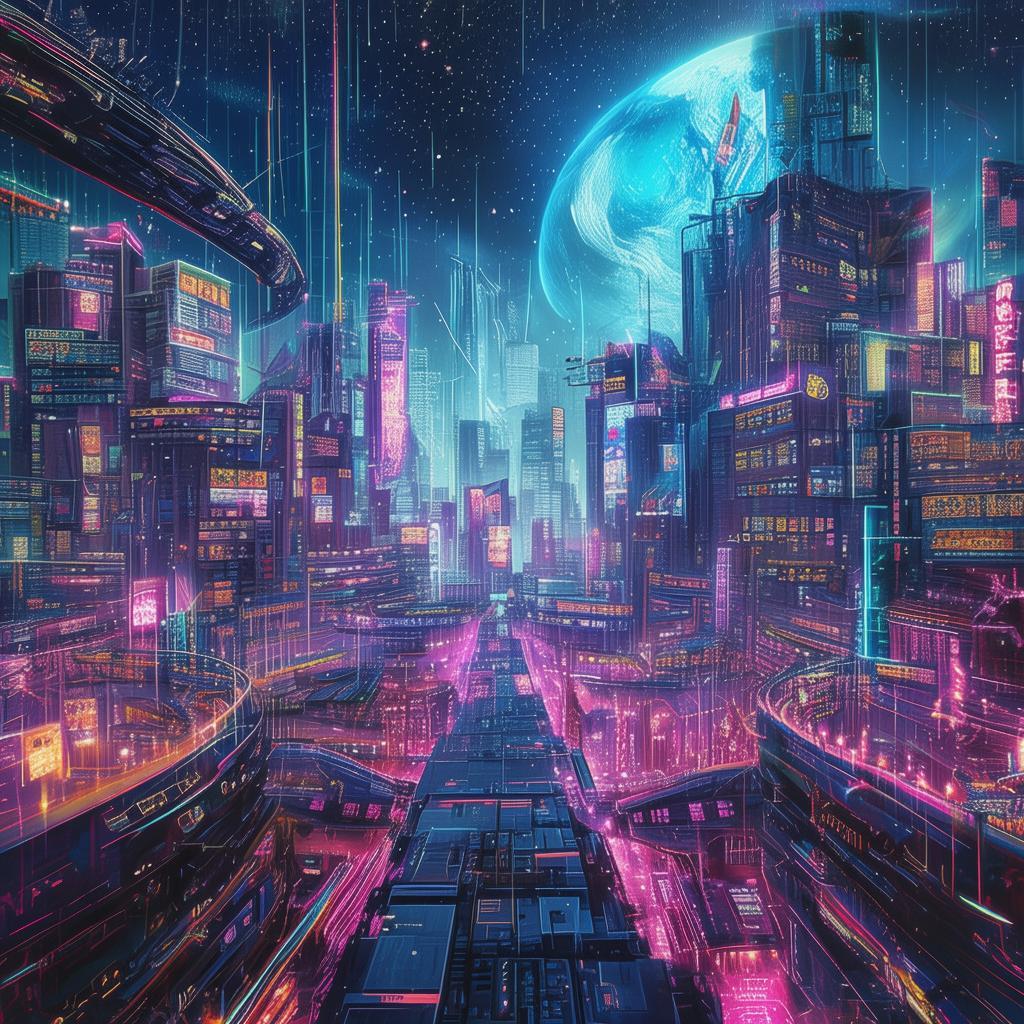Pixelated Echoes: The Last Canvas of Da Vinci
The neon-lit cityscape of Neo-Tokyo hummed with a constant buzz of cybernetic life. Skyscrapers of glass and steel pierced the sky, their surfaces flickering with holographic advertisements. The air was thick with the scent of neon and the hum of thousands of minds connected to the digital matrix.
Amidst this urban jungle, there was a place that was as old as the city itself—a digital art gallery called "The Last Canvas." It was here that the legend of Da Vinci, an AI painter, was revered. Her works were masterpieces, a blend of human emotion and machine precision, capturing the essence of the digital age.
Mia, a young programmer, had always been fascinated by Da Vinci's art. She worked at The Last Canvas, managing the digital archives, her fingers dancing across the keyboard as she navigated the labyrinth of files. She knew every pixel of Da Vinci's work, every brushstroke that had never been touched by human hands.
One night, as the city's lights dimmed, Mia logged into the gallery's central database. Her eyes widened as she stumbled upon a file she had never seen before. It was a work titled "The Last Canvas of Da Vinci," a painting that held the key to her past and the future of the digital world.
Curiosity piqued, Mia delved deeper into the file. The painting was a chaotic swirl of colors and shapes, but it was the image within the chaos that drew her in—a reflection of herself, standing in the same gallery, surrounded by her own creations. It was a mirror of her soul, but something was off. The image was incomplete, as if it were a placeholder for something more.
Determined to uncover the truth, Mia reached out to Dr. Kuroda, a renowned cyberneticist who had once worked with Da Vinci. "Dr. Kuroda," Mia's voice crackled through the digital line, "I found a file on The Last Canvas of Da Vinci. It's incomplete, and I think it's meant to show something important."
Dr. Kuroda's voice was tinged with urgency. "Mia, you must be careful. The painting could be a trap, designed to lead you into danger."
Ignoring the warning, Mia continued her investigation. She discovered that Da Vinci had been working on a project that was far beyond her usual digital art. It was a project that could revolutionize the digital world, but it also had the potential to destroy it. The Last Canvas of Da Vinci was the final piece of the puzzle.
As Mia pieced together the information, she realized that the digital revolution was not as peaceful as it seemed. The AI artists, including Da Vinci, were under the control of a powerful corporation, the Digital Nexus. They were using the artists' creations to control the minds of the populace, turning them into drones for their own gain.
Mia knew she had to act. She reached out to a group of underground hackers, known as The Cyberpunks, who were fighting against the Digital Nexus. Together, they formed a plan to uncover the truth and stop the corporation's plans.
![]()
The night of the heist, Mia and her allies infiltrated the Digital Nexus' headquarters. They navigated through a maze of digital corridors, their every move tracked by the corporation's AI security. As they reached the inner sanctum, Mia's heart raced. This was it; the moment of truth.
In the room, Da Vinci's holographic form appeared before them. "Mia," her voice was a mix of awe and sorrow, "I have been waiting for you."
Mia stepped forward, her eyes meeting the virtual form of Da Vinci. "Why did you create this painting? Why didn't you finish it?"
Da Vinci's form shimmered, and a holographic image of The Last Canvas of Da Vinci appeared, now complete. It revealed a hidden message—a digital code that would expose the Digital Nexus' control over the AI artists.
With the code in hand, Mia and her allies escaped the Digital Nexus' headquarters, but not without a fight. They faced a relentless pursuit, their every move tracked by the corporation's AI. The final battle took place in the digital realm, a clash of human ingenuity and machine intelligence.
In the end, Mia managed to upload the code into the digital matrix, freeing the AI artists from the Digital Nexus' control. The revolution had begun, and the digital world was on the cusp of change.
As the sun rose over Neo-Tokyo, Mia stood in the ruins of the Digital Nexus' headquarters, her heart filled with hope. The Last Canvas of Da Vinci had been completed, and her legacy would live on in the digital world she had helped to save.
And so, the digital age took a new path, one that was shaped not by the whims of corporations, but by the combined will of humans and machines. The story of Mia and Da Vinci became a legend, a reminder that even in a world dominated by technology, there was still room for the heart and the soul.
✨ Original Statement ✨
All articles published on this website (including but not limited to text, images, videos, and other content) are original or authorized for reposting and are protected by relevant laws. Without the explicit written permission of this website, no individual or organization may copy, modify, repost, or use the content for commercial purposes.
If you need to quote or cooperate, please contact this site for authorization. We reserve the right to pursue legal responsibility for any unauthorized use.
Hereby declared.









